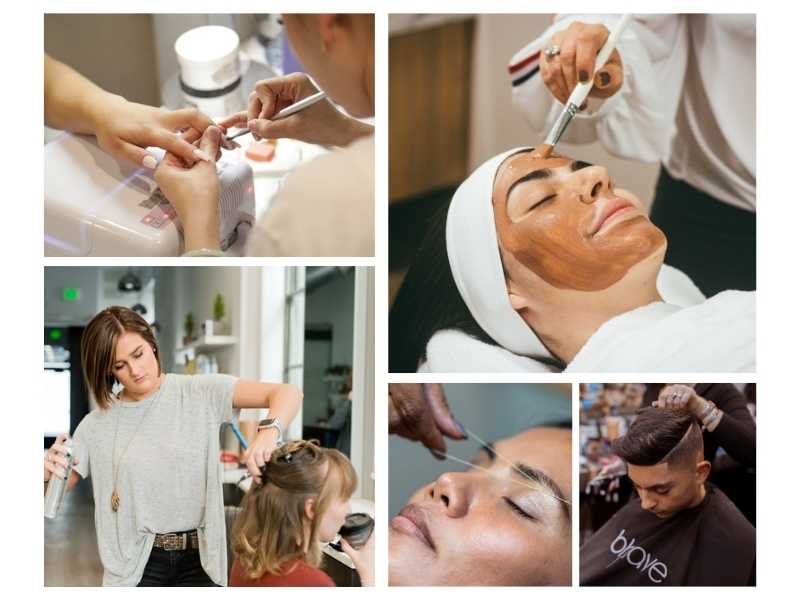
How To Run and Grow a Salon Business
Thinking of starting your own salon business in 2022?
We can safely say that it’s definitely a great time!
While it’s true that the salon and beauty industry has been heavily affected by the global pandemic situation throughout 2020 and 2021, it has since bounced back and is expected to grow to an $87 billion global industry in 2023.
Yet, just because starting a salon business is definitely a lucrative business opportunity doesn’t mean it’s easy to start and run one.
Success is obviously not guaranteed, and many salon businesses will fail, especially when they are not well-planned. Having a clear strategy on how to run and grow a salon business is important, and in this guide, we will learn how.

In this guide, we’ll discuss all you need to know about starting, running, and growing a successful salon business, and by the end of this guide, you’d have learned about:
- Different types of salon businesses you can start
- Key considerations before opening a salon business
- How to estimate the cost to open a salon business
- How to create a business plan
- How to market your salon to get you more clients
And more.
Without further ado, let us begin right away.
What is a Salon Business?
A salon business, or to be exact, a beauty salon business, is a brick-and-mortar establishment that provides cosmetic treatments for its clients.
There are many types of cosmetic services that may be offered by a beauty salon business, including but not limited to:
- Hair-related treatments (salons that specialize in hair treatments are distinctively called “hair salons” rather than beauty salons)
- Facial treatment
- Massage and spa services
- Manicures and pedicures for the nails
- Hair removal (i.e., waxing)
- Oxygen therapy
- Mud baths
And so on.
Beauty Salon VS Beauty Parlor
Although the terms are often used interchangeably, there’s a difference between a beauty salon and a beauty parlor.
Typically a beauty salon is a well-established space located in a (rented or purchased) commercial property. A beauty salon typically offers several types of services to its clients (an all-in-one, holistic service provider), while most beauty parlors focus on providing specific treatments.

Beauty parlors are typically smaller; many of them are located at the owner’s home. In many business parlors, the owner is also often the service provider (i.e., hairstylist.)
Different Types of Salon Businesses
Based on its business model, salon businesses can also be differentiated into four major types:
- Traditional: the salon is set up on a commercial property. You can either rent or purchase the property; purchasing a property will require a bigger capital, but you’ll get more freedom in renovating and decorating the space.
- Home-based: we have discussed how most smaller beauty parlors are home-based. If you have a large enough space in your house, then you may want to consider starting the salon as a home-based business, which can significantly lower your startup cost. However, pay attention to local regulations that may apply before opening a home-based salon.
- Mobile: in this salon business model, you (or your service providers) will visit your clients and provide the cosmetic treatments on their premises. Lower startup costs (even when compared to home-based business), but marketing and scaling a salon with this model can be more challenging.
- Franchise: in this model, you are licensing a salon of an existing brand that offers franchise opportunities. You’ll have an easier time in setting up the salon since you’ll get support from the franchisor, like in training your employees and in marketing your business, but the initial startup investment will be higher. Also, you’ll obviously have less freedom in developing your own brand and scaling your business.
Key Considerations Before Opening a Salon
As mentioned, you’ll need careful planning and a proper strategy to ensure the success of your salon business, and here are some of the most important factors to consider before starting a salon business:
- Location, location, location
Since a salon business will always involve physical interactions, whether you choose the right location or not can literally make or break the salon business’s success.
As early as possible in the planning process, decide whether you are going to start the salon as a home-based business or whether you are going to rent or purchase a property.

Purchasing a property will provide you with the most freedom to set up a salon business but will also be the most expensive option. On the other hand, starting a home-based salon is the most affordable option, but you’ll be faced with various limitations.
Nevertheless, whether you’d want to rent or purchase a property, here are some factors to consider when choosing a location for your salon business:
- Whether there is enough space for the services, you’d like to offer (more on this below). As a general rule of thumb for a standard hair salon, a 500 sq ft salon can fit three hair salon chairs.
- Evaluate public transportation options near the location
- Evaluate parking space availability, especially if you are planning to open a premium salon
- Evaluate whether your clients would be able to easily distinguish your salon from other stores in the area after considering signage design, decoration, and other factors
- Check whether there are other properties nearby available for rent or purchase. This is so you can plan for scalability.
- Define your salon’s concept
As discussed, salons can come in many different types and sizes, so before starting a salon business, you should decide the details of what type of salon you’d like to open and run.
First, decide on what kind of service(s) your salon is going to offer.

Here are some of the most common services offered by a salon:
- Hairdressing and hairstyling (including coloring)
- Nails treatment (manicure and pedicure)
- Skin treatments and facials
- Hair removal (waxing)
- Massage services (spa)
- Tanning
You can either be a specialist and offer just a single (or a few) cosmetic services, for example, a hairdressing salon. Or, you can be an all-rounder beauty salon offering many different services in a single facility.
Based on your target audience and other factors, you can also decide on the pricing ranges you are going to offer for your services:
- Beauty parlor: smaller salons (can be home-based) typically offer relatively affordable services and only use more affordable products and supplies. Typically the owner is also the main service provider.
- Beauty salon: more expensive than a beauty parlor and employs at least one professional (i.e., professional hairstylist). You can offer more complex and varying services.
- Premium salon: offering more professional service providers and higher-end supplies, and the salon is equipped with more advanced technology and equipment.
- Luxury salon: all-in-one salon offering services to premium clients. A premium location with high-end decoration is a must, preferably with famous cosmeticians/hairdressers and high-quality supplies.
- Who is your market?
Before planning and opening a salon business, it’s very important to first identify and understand who your target customers are.
Perform thorough market research and develop a buyer persona for your ideal client. A buyer persona is a semi-fictional model describing someone who represents your ideal audience; the more detailed your buyer persona is, the better.
Also, perform a competitive analysis to check the direct and indirect competitors in the area. This is also a good approach to determine what kind of market is available in the area.

Use the data gathered in your market research and competitive analysis to plan your salon concept/design and plan what is your salon’s unique value proposition (UVP): what makes your salon unique from the competitors in your area?
The better you understand who your target clients are, the better you can set up your salon to meet your client’s expectations, and the better you’ll be able to market your salon business.
In short, do your market research and competitive analysis homework.
- How are you going to promote your business?
Planning and setting up the perfect salon is one thing, but it won’t be a successful business if you can’t attract enough clients to visit your salon and, even better, repeatedly use your services.
However, we all know how marketing a salon business (or any business at all) amidst the competition can be easier said than done. It’s very important for salon owners to do their market research and competitive analysis homework and develop a comprehensive marketing plan accordingly.
- Ensuring compliance with regulations
Depending on where you are going to open your salon business, there may be specific local, state, or federal regulations you’d need to take into account before you can open your salon business.
Check out whether there are any legal requirements you must fulfill, and depending on the types of services you are offering, there may also be additional requirements you’ll need to comply with.

For example, if you are offering facials, you may be required to possess special permits and licenses, depending on your location.
It’s best to check with the relevant local association(s) in the area to check about the requirements you’ll need to fulfill, but at the very least, you may be required to own:
- A salon license
- A building permit (if you rent/purchase a property)
- Relevant insurance, depending on your area and the services you are offering
- OSHA compliance
- Pricing strategy
Technically, pricing strategy should be a part of the salon’s marketing plan, but it deserves a special mention due to its importance.
Figuring out how much to charge for your services can be quite challenging in a salon business: charge too high, and you may not be able to attract enough clients. Charge too low, and people may perceive your salon as a low-quality one, and obviously, charging too cheap may also hurt your profitability.

One of the best approaches here is to perform a competitive analysis and check how much the competitors in your area are pricing their services. However, this doesn’t mean you should always aim to undercut their prices. If you are confident about your service’s value, it’s okay to charge more than your competitors.
Salon Marketing: Attracting and Retaining Clients
You’ve picked the perfect location for your salon, the perfect decor, and have hired the best hairstylists and cosmeticians in town.
Yet, if you can’t attract enough clients to your business, your salon is doomed to fail.
Having a clear-cut marketing strategy is very important if you really want to achieve success and grow your salon business, and in this section of this guide, we will discuss how.
Salon Marketing: The Basics
When marketing a salon business, it’s crucial to understand that you are marketing services instead of physical goods. While you may sell shampoo, hair wax, or other products at your premises, they aren’t your core offering.
With that being said, marketing and promoting a service would require a different approach. Clients can’t see or touch the service, and they won’t own it after a “purchase.” Thus, it’s more difficult to prove your value to prospective clients.

So, the main idea of marketing a salon as a service business is to build credibility and establish trust. If you can convince potential clients that what you offer is valuable and is an ideal solution for their problems, you can get them to come and visit your salon.
So, how can we establish the credibility of our salon? There are several main pillars of salon marketing we should focus on for this purpose, which we will discuss in the next section.
Key Pillars of Salon Marketing
1. Strong and Memorable Brand
Since the salon’s main focus is not to sell physical goods but rather selling the salon itself, strong branding is crucial, or else you won’t get noticed amidst the competition.
Branding your salon is a pretty deep subject on its own, and you might want to check this guide by Squarespace on salon branding to learn more.

However, here are some actionable tips you can use:
- Decide on a name that is easy to pronounce, catchy, and easy to remember. The name should clearly communicate what your salon offers.
- Design a logo that supports your brand name and one that meets your target audience’s preferences. How would you like your clients to perceive your business?
- Decide on brand colors that can support your logo’s design and can communicate your brand’s message.
Last but not least, establishing a strong brand is ultimately about consistency. All the visual branding elements of your salon should always appear consistent, whether on your website, social media posts, or even printed promotional materials like your posters and brochures.
Also, all your marketing and promotion efforts should align with this brand identity.
2. Strong Online Presence
In today’s social media age, even brick-and-mortar businesses, including a salon, must have a strong online presence, or else your prospective clients won’t notice you.
Establish a strong online presence by focusing on these four aspects:
- A well-designed and functional website
Your website is akin to your salon’s online business card and will often be the first thing your prospective clients will check before making a visit to your premises.
As we know, first impressions do matter: if your website seems credible and well-designed, your business will also be perceived as credible. On the other hand, if your site looks cheap and full of errors, they won’t visit.

Make sure your website is:
- Mobile-friendly, easily read on mobile devices, and your clients can easily book your services straight from their phones.
- Intuitive, easily navigable.
- Fast. According to Google, 50% of users will leave a website that loads in more than three seconds on standard connectivity.
- Informative. It should contain all the information relevant to your salon, like the services you offer, business hours, prices, and so on.
- Social Media Presence
Literally, everyone is on social media these days, including your prospective clients. So, it would only make sense to promote your salon on relevant social media networks.
Yet, all your competitors will also do the same, so how can you get noticed amidst all the social noises?

Creativity and a thorough understanding of your target audience are keys, but you should also understand that there are three different channels you can leverage when it comes to social media marketing:
- Organic: building your own followers and regularly posting high-quality content for your audience to promote your salon. Organic social media efforts can be totally free, but you’ll need some time before you can get the desired results.
- Paid: using the paid advertising and promotion options offered by the social media networks to promote your salon business (i.e., Facebook Ads, Instagram Ads.). It can be very effective in generating quick results, but if not managed well, it can cost your profitability.
- Influencer marketing: influencer marketing can be considered a part of social media marketing. Partnering with the right influencers and letting them promote your salon to their followers can be very effective both in the short term and long term.
To build a strong social media presence, it’s crucial to leverage all three channels, and the secret is finding the right balance between the three: organic efforts to lower your costs and paid/influencer marketing efforts to generate quick results.
- Google Maps
Nowadays, there are two main ways people learn about new local businesses, including salons: via social media, for example, when someone they followed mentioned your salon, and via Google search.
Your prospective clients will use local queries like “salon near me” or “best salons in NYC” when they are looking for a salon. So, it’s crucial that your salon should appear in their search results for these queries, or else you won’t be noticed.
A key thing to consider for these local queries is that now Google will prioritize results from Google Maps, so it’s very important to make sure your salon business has an optimized Google Maps listing that ranks high for the relevant search queries.

In short, you’ll need to perform local SEO or Google Maps SEO, which you can do in just four simple steps:
- Create or claim a Google Business listing. Make sure it’s verified, or else Google won’t prioritize you in search results.
- Optimize your Google Business profile. Focus on providing complete and accurate information for prospective clients. Don’t forget to include well-taken photos of your salon and its workers.
- Get more (positive) reviews from existing clients, especially on your Google Maps listing, but also on relevant review platforms for your salon business (i.e., TripAdvisor, Facebook Places, etc.)
- Build local citations by listing your salon on relevant online directories (online directories for salon businesses and online directories for businesses in your area).
Do these four steps consistently, and you’ll see your business listing climb the Google Maps search result.
- Online reservation
Clients nowadays simply expect easy-to-use 24/7 online reservations. Getting prospective clients to be aware of your salon business is already challenging enough, and you wouldn’t want them to neglect using your services just because it’s too difficult to book your salon.
Proper scheduling and booking software for salons can help in facilitating this by offering easy integrations of online appointment software and tools on your website.

3. Customer Retention Strategy
Consistently acquiring new clients is indeed important, but retaining existing clients and keeping them to come back to your salon is arguably even more profitable.
There are several things you can do to maximize customer retention:
- Customer loyalty program: you can start a fully-fledged customer loyalty program, or you can start simple, for example, by offering discounts after their 5th or 10th visit.
- Email marketing: don’t underestimate the power of email marketing, even with all the newer technologies and marketing tactics. If you already have integrated a salon scheduling solution, it should automatically collect your clients’ email addresses as they book your service online, and you can use this list to start your email marketing right away.

- Encourage referrals: offer group discounts to encourage your clients to visit your salon together with their friends. Or, you can start a referral marketing program and offer commissions for clients who bring in others to your salon.
4. Building Relationships
While all the digital marketing efforts are obviously very important in today’s digital environment, don’t underestimate the importance of building relationships with other businesses, media, and relevant individuals in your area.
Engage your local community, and consider joining local trade shows and expos. These can be great opportunities not only for building new partnerships but also for meeting potential clients.
If possible, join a local social cause. Not only will it feel good to give back to your community, it can also help in generating more awareness and interest for your salon.
Wrapping Up
While starting and growing a salon business can be challenging, the secret remains about a better understanding of your target audience and knowing how you can deliver value to them.
By following the tips we’ve shared above, you can effectively grow your salon business: acquire new clients while retaining existing ones and grow your profit.

